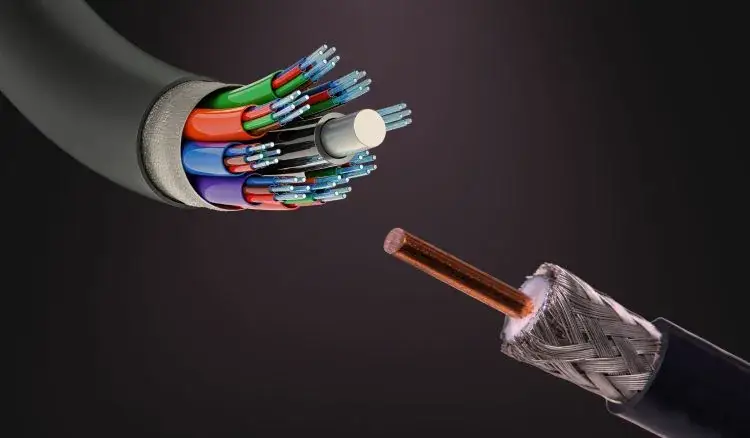Coaxial cables and fiber optics are two types of transmission mediums used in telecommunications and networking, each with its own set of advantages and disadvantages.
Coaxial cable and fiber optics represent two distinct yet vital technologies for transmitting signals and data in modern telecommunications and networking systems.

Coaxial cable, commonly referred to as coax cable, is a type of electrical cable that is widely used for transmitting television signals, internet data, and other communication signals.
Other other hand, Fiber optics is a technology that uses thin strands of glass or plastic fibers to transmit data in the form of light pulses.
Coaxial Cable and Fiber Optics:
Coaxial cable and fiber optics represent two distinct yet vital technologies for transmitting signals and data in modern telecommunications and networking systems.
Coaxial Cable
Coaxial cable, commonly referred to as coax cable, is a robust electrical cable known for its versatility and reliability in transmitting various signals. It features a central conductor encased within a dielectric insulator and shielded by a metallic layer. Coaxial cables find widespread use in telecommunications, cable TV distribution, internet connectivity, and CCTV systems due to their durability and efficient signal transmission capabilities.
Advantages of Coaxial Cable:
- Durability: Coaxial cables are rugged and can withstand physical stress better than some other types of cables.
- Versatility: They can transmit various signals, including television, internet, and CCTV, making them suitable for diverse applications.
- Cost: Coaxial cables are generally less expensive to install and maintain compared to fiber optics.
Disadvantages of Coaxial Cable:
- Limited Bandwidth: Coaxial cables typically offer lower bandwidth compared to fiber optics, limiting their application in high-speed data transmission over long distances.
- Susceptibility to Interference: They are susceptible to electromagnetic interference (EMI) and radio frequency interference (RFI), which can degrade signal quality, especially over long distances.
Fiber Optics
Fiber optics, on the other hand, is a cutting-edge technology that revolutionizes high-speed data transmission over long distances. It utilizes thin strands of glass or plastic fibers to guide light signals, offering high bandwidth and immunity to electromagnetic interference. Fiber optic cables consist of a core surrounded by a cladding layer, enabling efficient signal transmission with minimal loss. Fiber optics play a crucial role in telecommunications networks, internet backbone infrastructure, and high-speed data transmission applications, powering the digital age with unparalleled connectivity and performance.
Advantages of Fiber Optics:
- High Bandwidth: Fiber optics offer significantly higher bandwidth compared to coaxial cables, enabling the transmission of large amounts of data over long distances at high speeds.
- Immunity to Interference: They are immune to electromagnetic interference and radio frequency interference, ensuring reliable signal transmission even in noisy environments.
- Low Signal Attenuation: Fiber optics experience minimal signal loss over long distances, making them ideal for transmitting data over extensive networks.
Disadvantages of Fiber Optics:
- Cost: Fiber optic cables are generally more expensive to install and maintain compared to coaxial cables due to the cost of specialized equipment and materials.
- Fragility: They are more fragile than coaxial cables and require careful handling to prevent damage to the delicate glass or plastic fibers.
Coaxial Cable Vs Fiber Optics
Coaxial cable, often simply called coax cable, is a type of electrical cable known for its robustness and versatility in transmitting various signals. It comprises a central conductor, typically made of copper or aluminum, encased within a dielectric insulator, which is then shielded by a metallic layer.
Fiber optics represents a cutting-edge technology for transmitting data over long distances at high speeds. It relies on the principle of guiding light through thin strands of glass or plastic fibers. A typical fiber optic cable consists of a core made of optical fibers surrounded by a cladding layer that reflects light back into the core.
| Feature | Coaxial Cable | Fiber Optics |
|---|---|---|
| Structure | Central conductor, dielectric insulator, metallic shield, outer insulating layer | Core made of optical fibers, cladding layer, outer jacket |
| Signal Transmission | Electrical signals transmitted through the central conductor | Data transmitted as light pulses through optical fibers |
| Bandwidth | Lower bandwidth compared to fiber optics | Higher bandwidth, capable of transmitting large amounts of data |
| Cost | Generally less expensive to install and maintain | More expensive due to specialized equipment and materials |
| Durability | More durable and less fragile | More fragile and requires careful handling |
| Interference | Susceptible to electromagnetic and radio frequency interference | Immune to electromagnetic interference, less susceptible to signal degradation |
In summary, coaxial cables are more cost-effective and durable for short to moderate distance transmissions with moderate data rates, while fiber optics offer higher bandwidth and immunity to interference, making them suitable for long-distance, high-speed data transmission applications.



